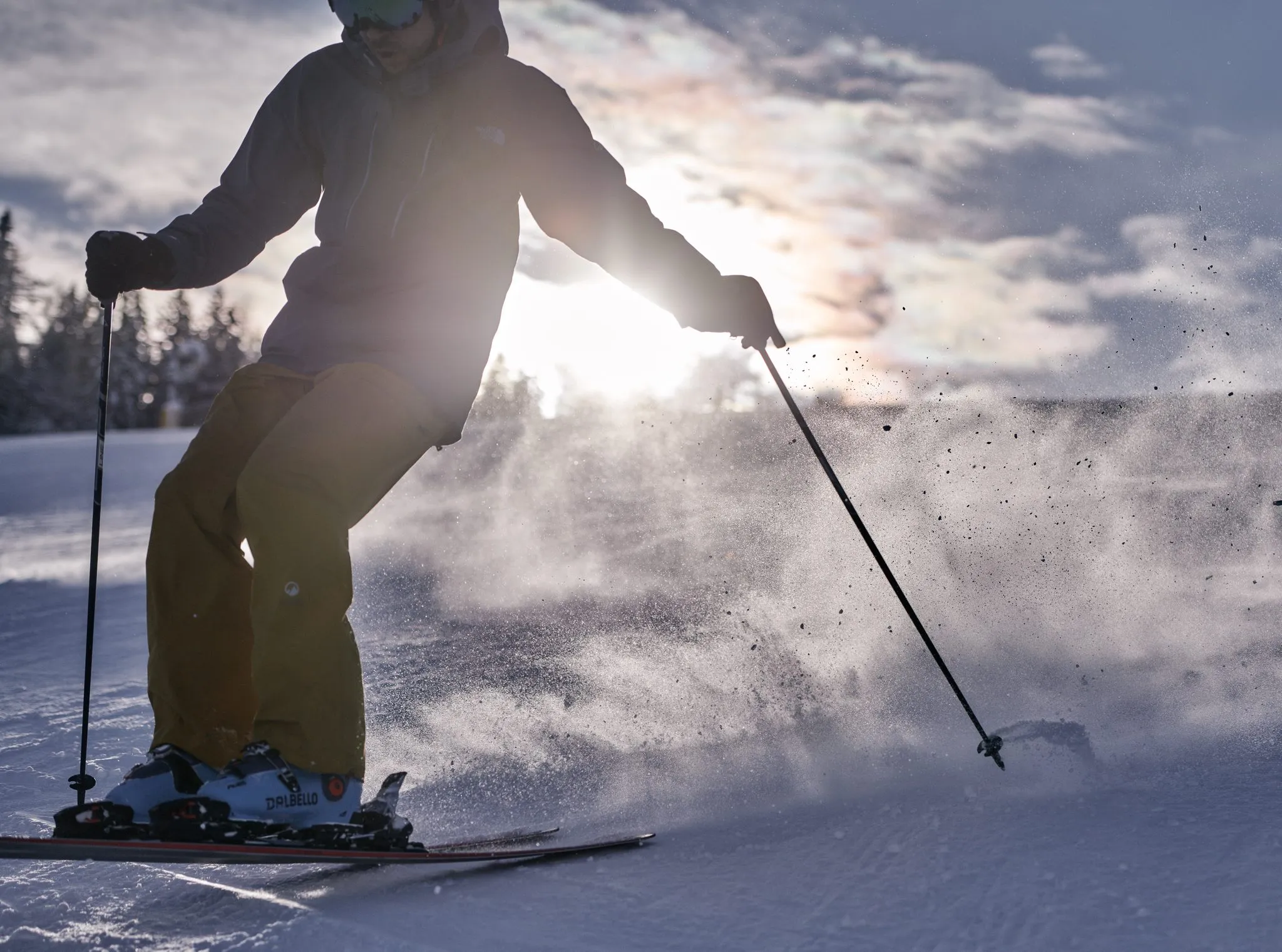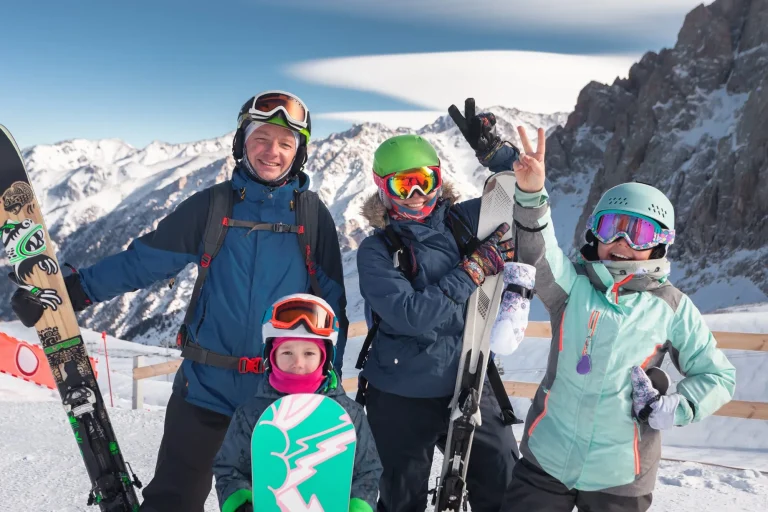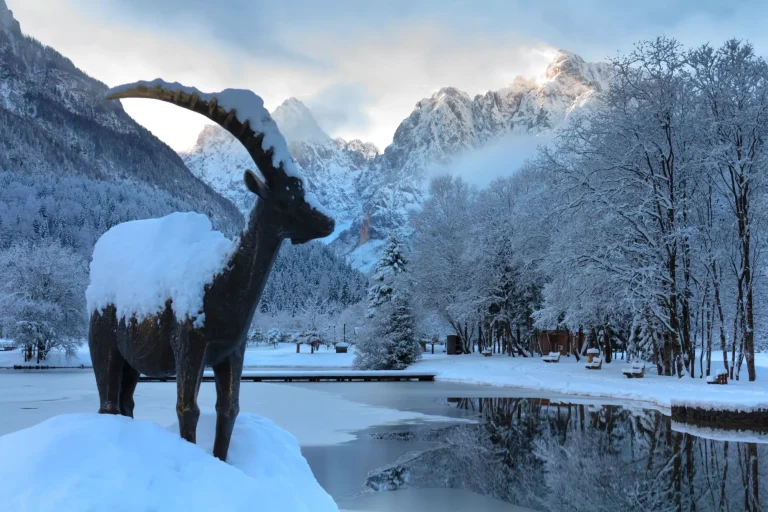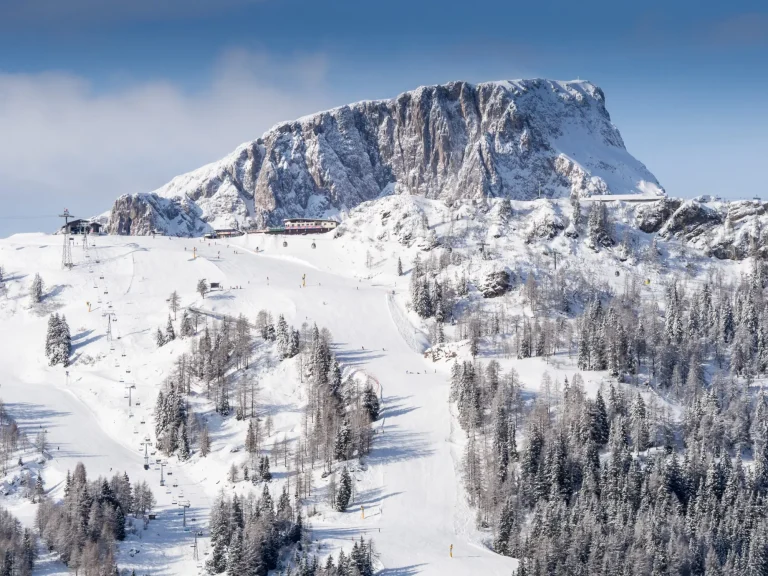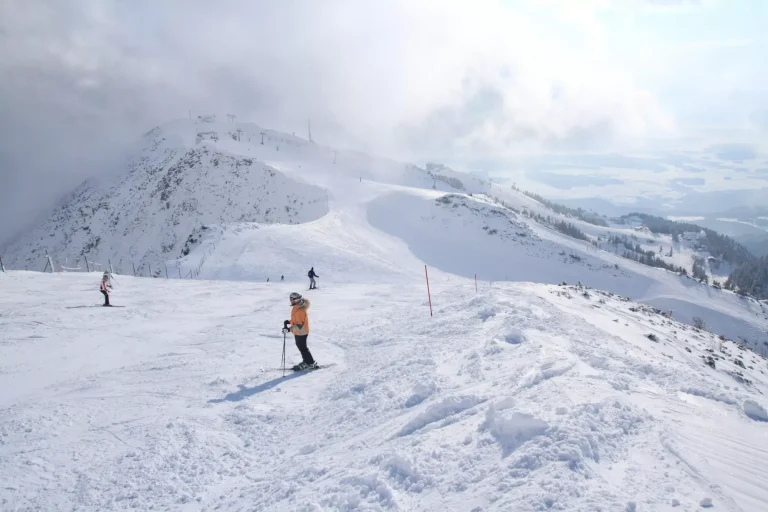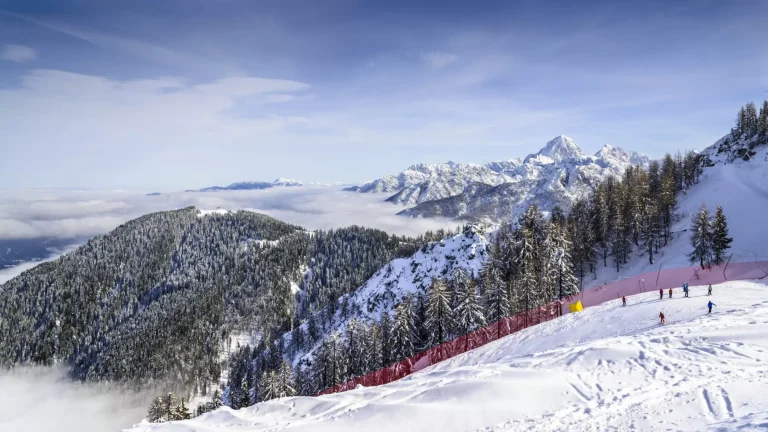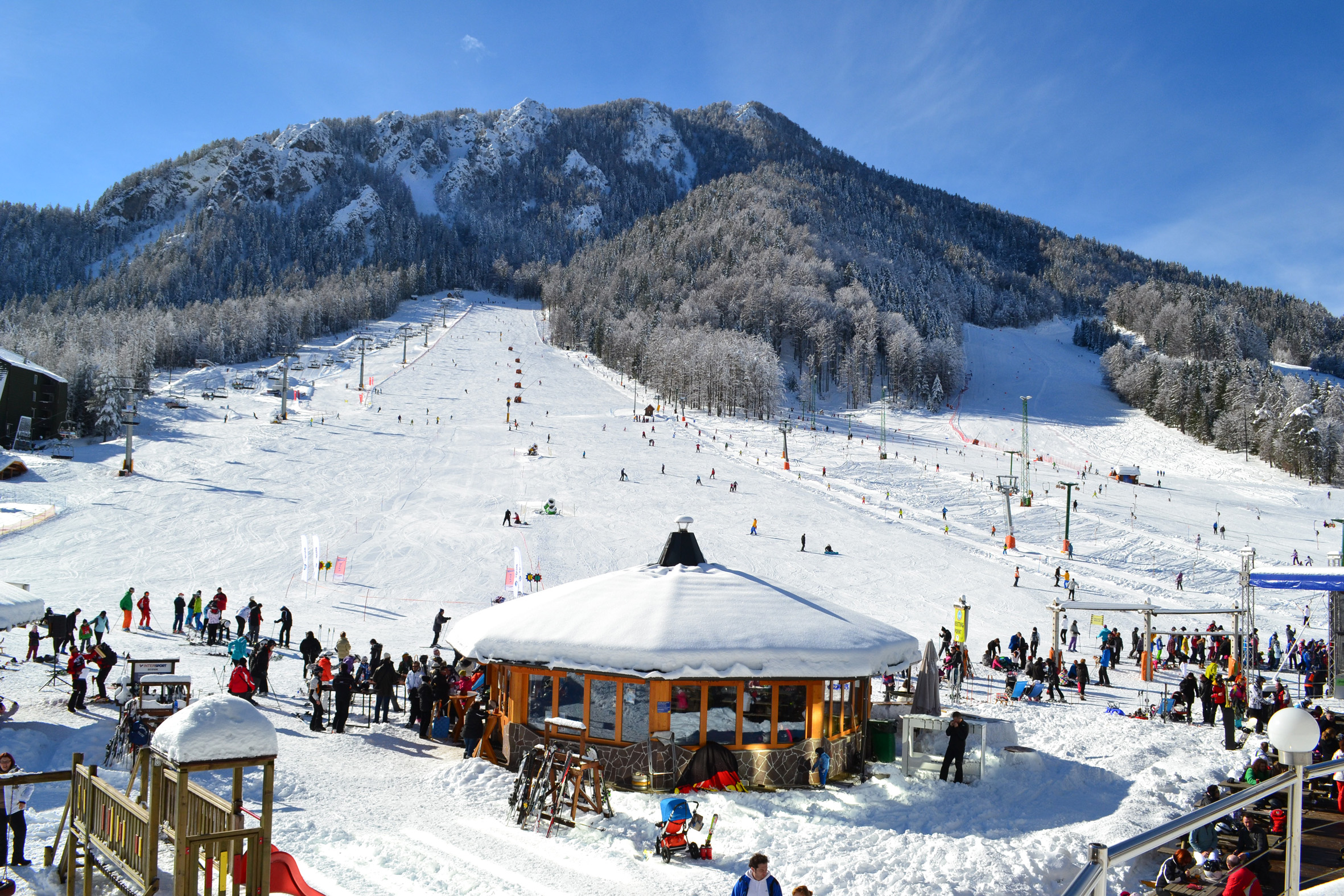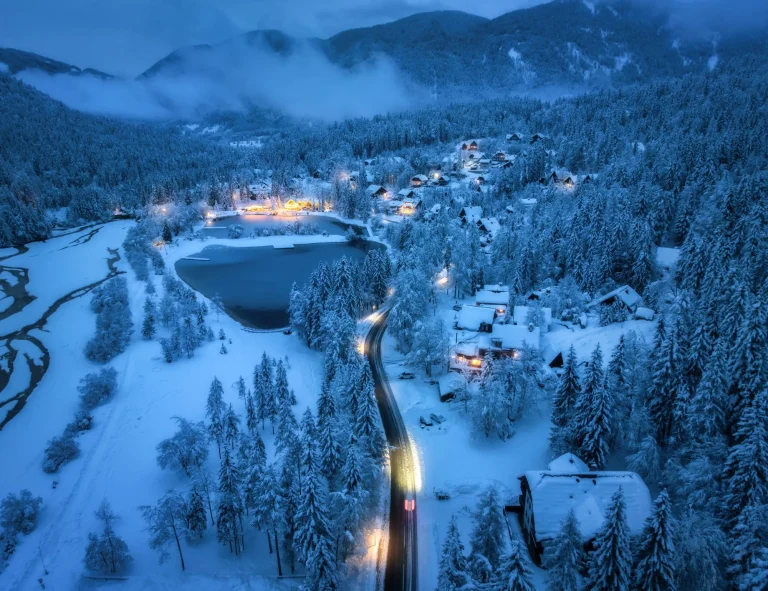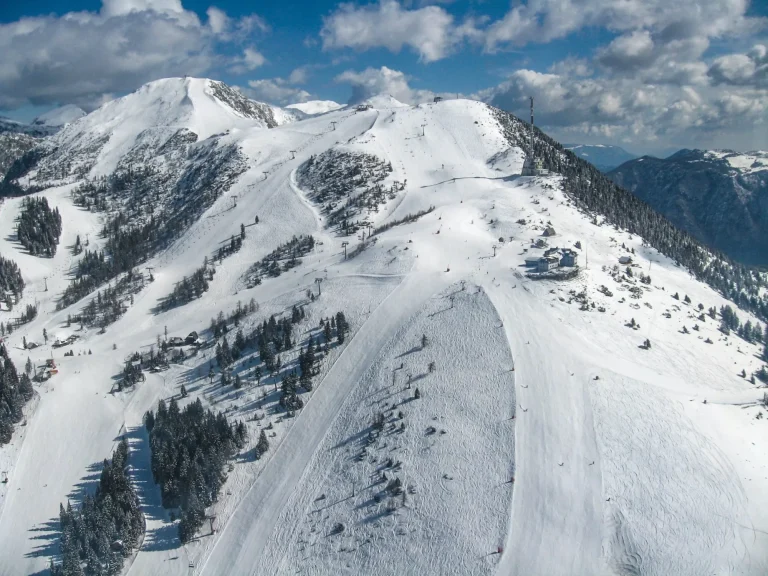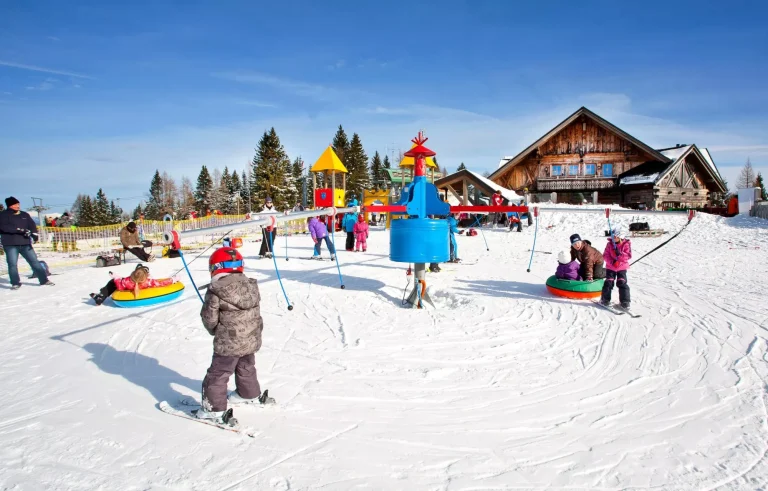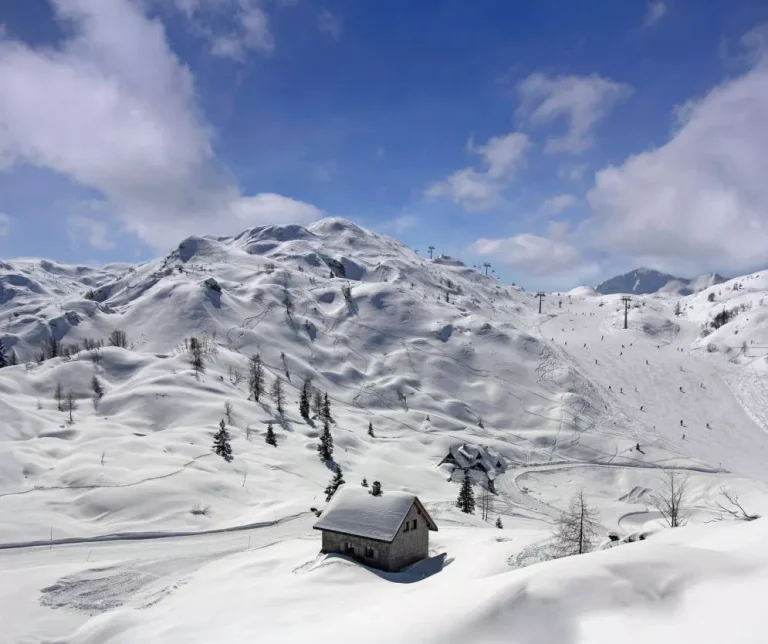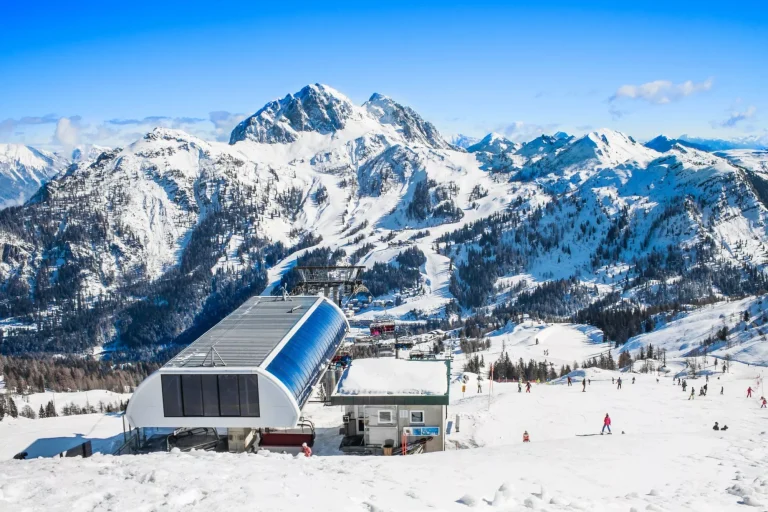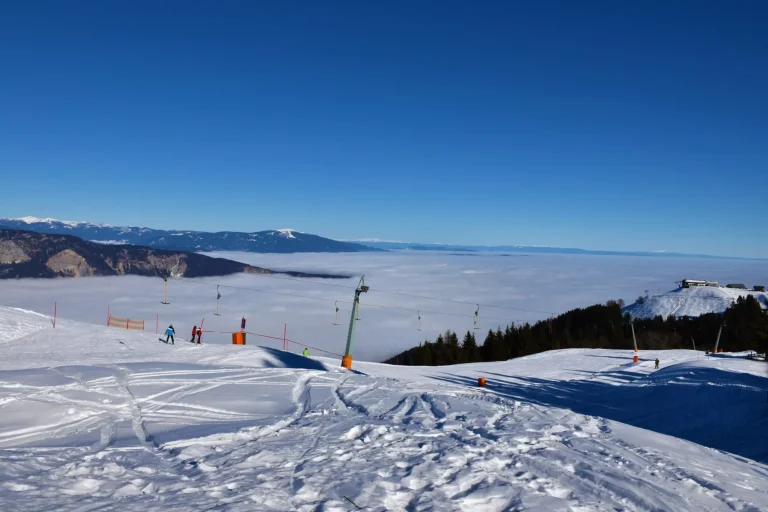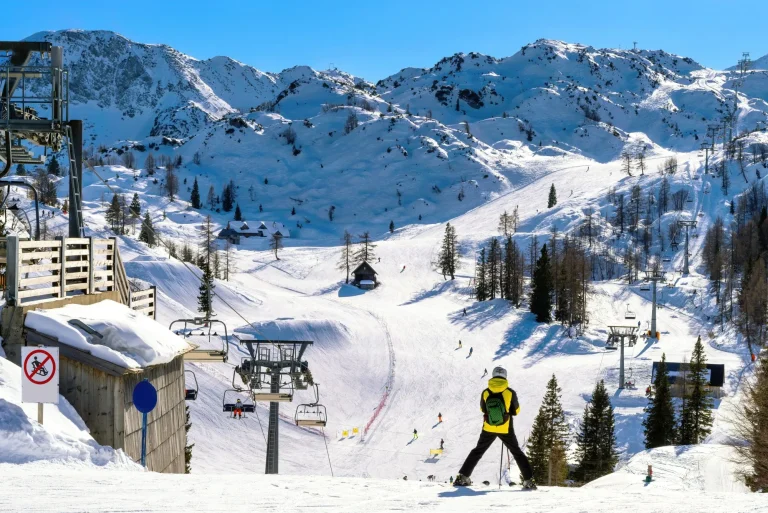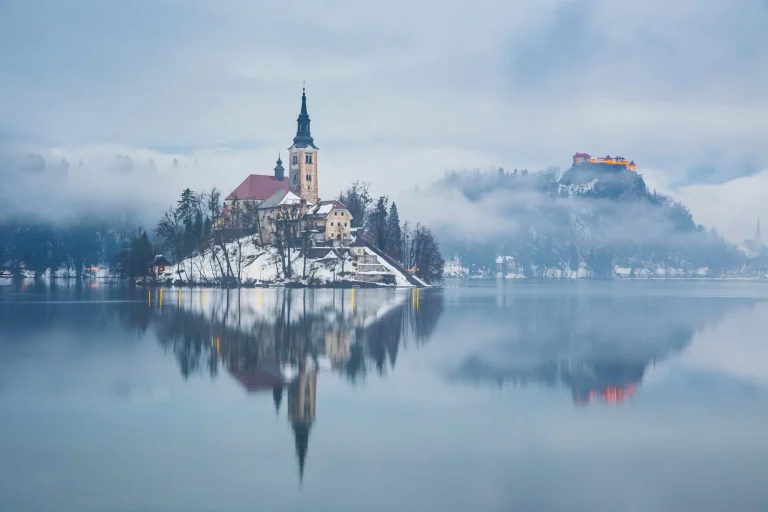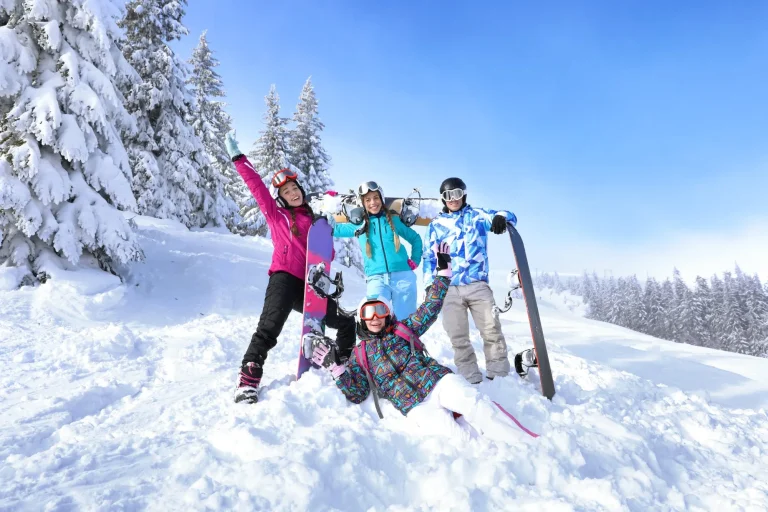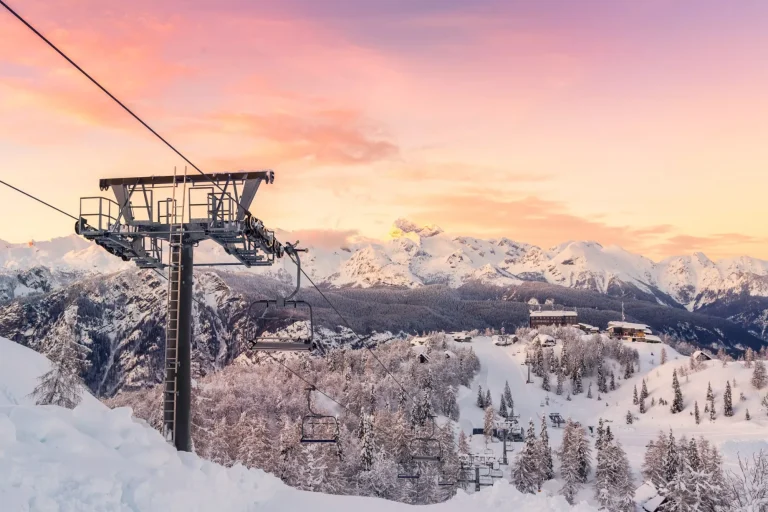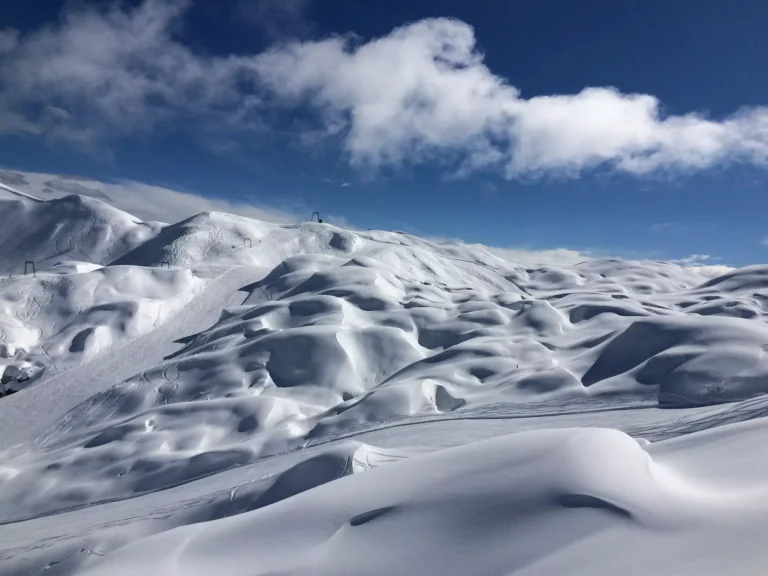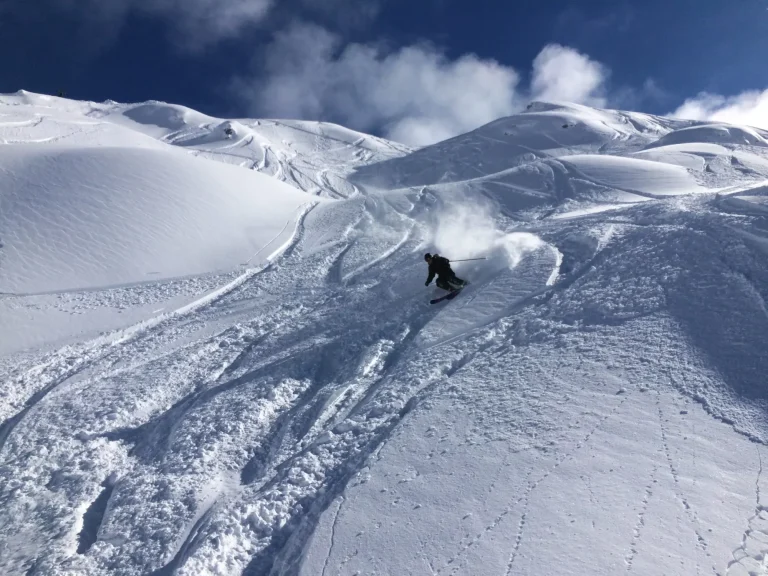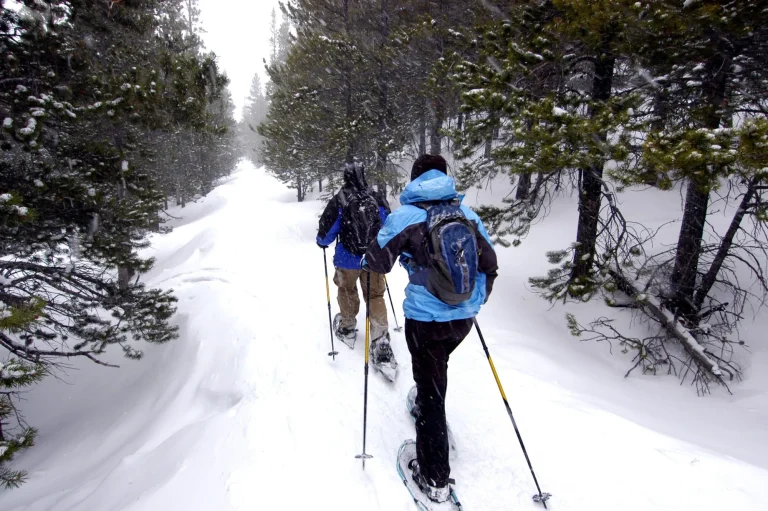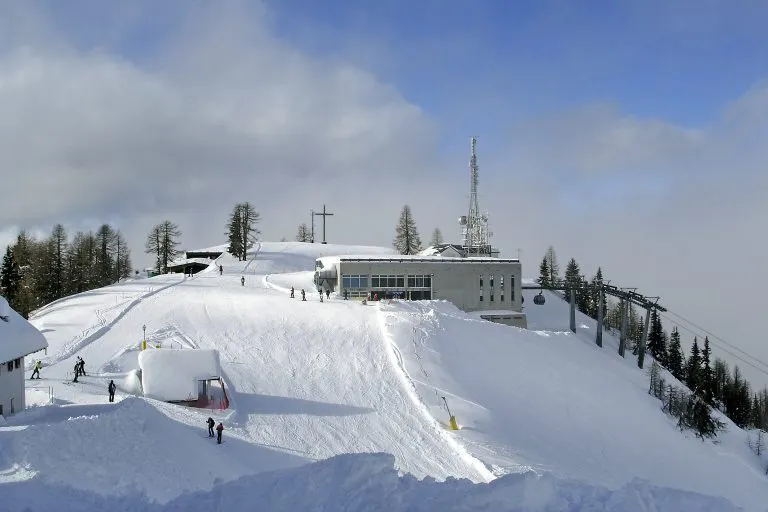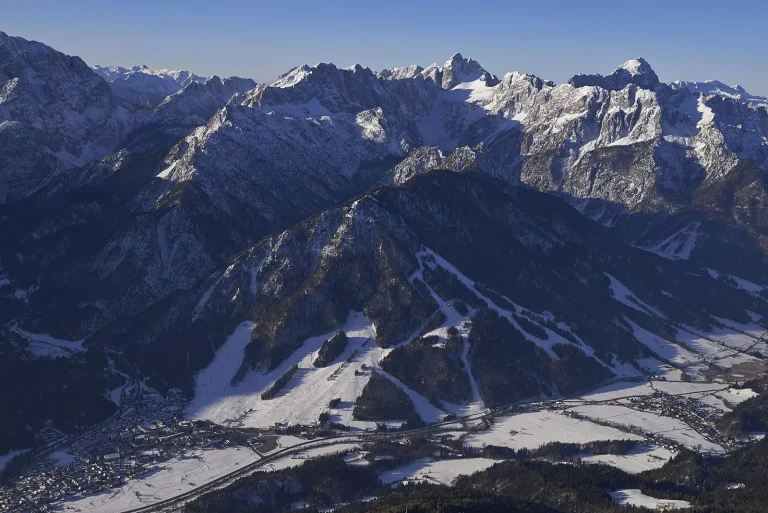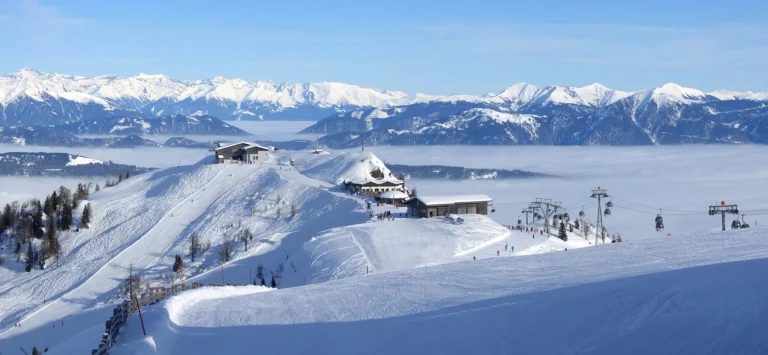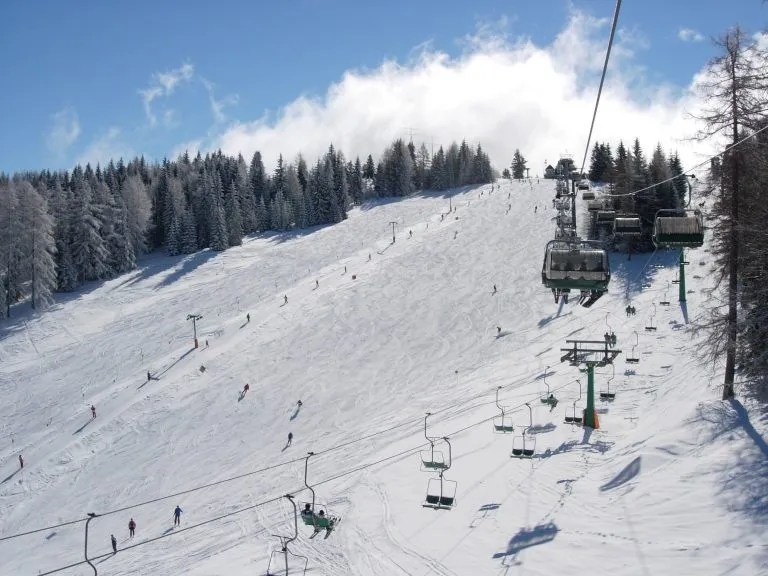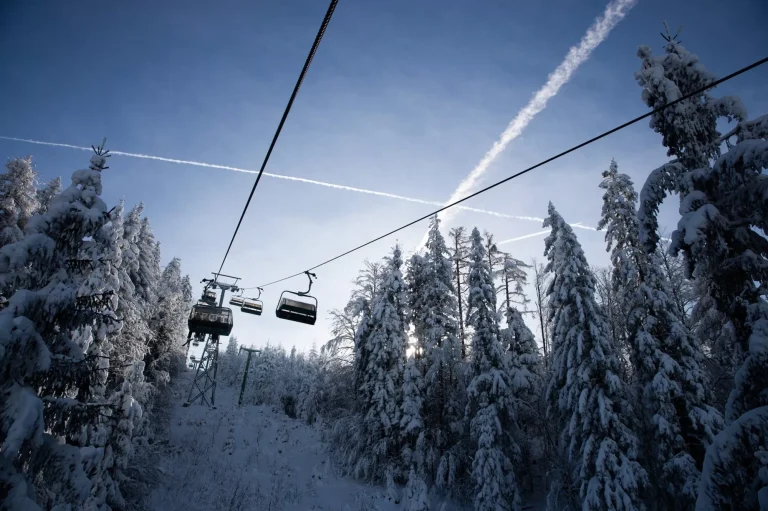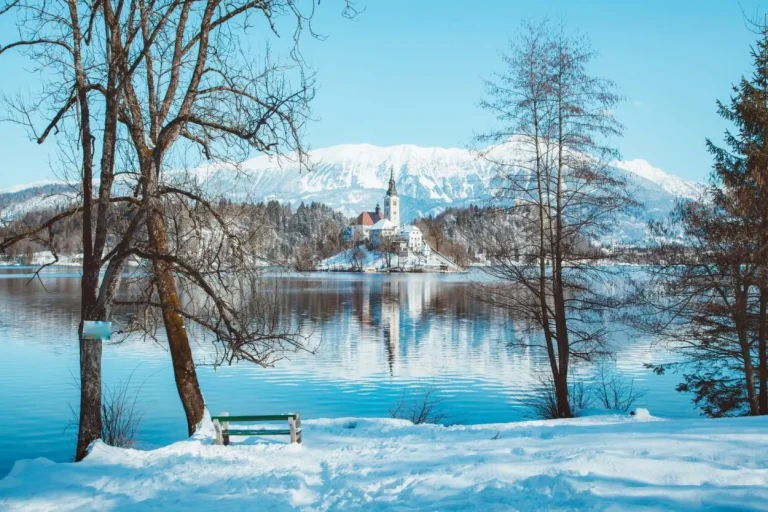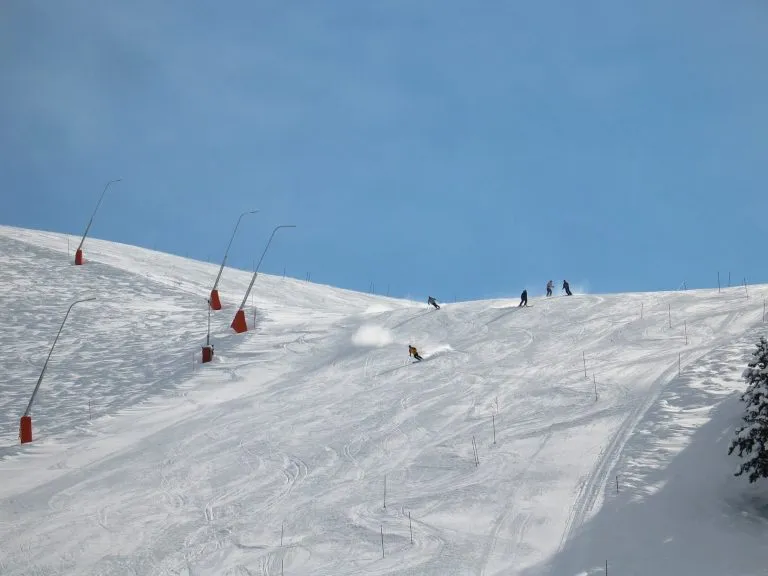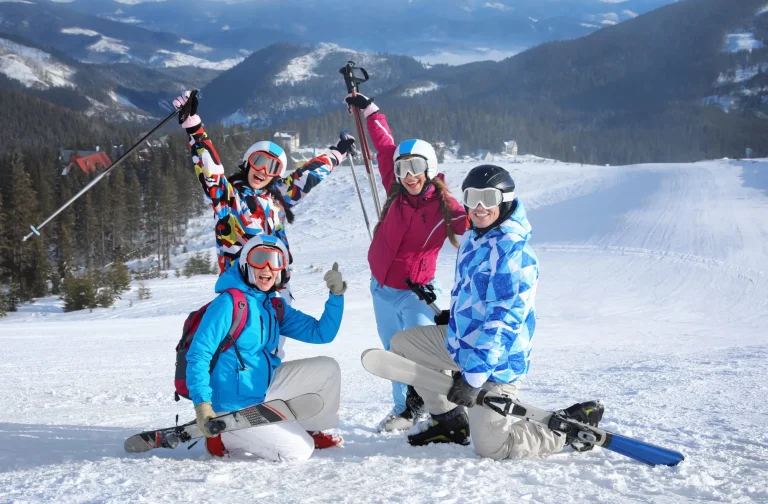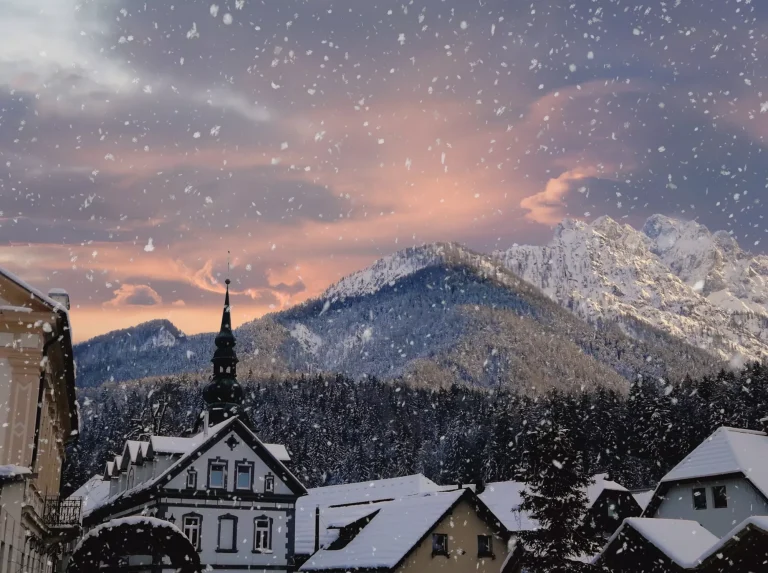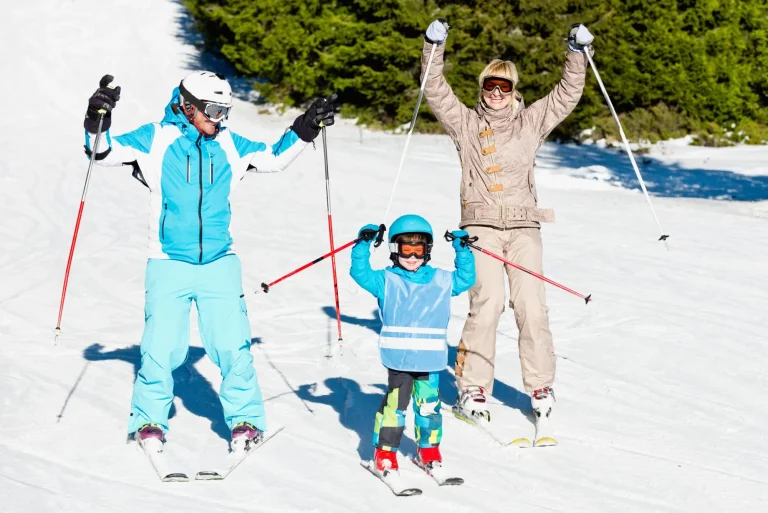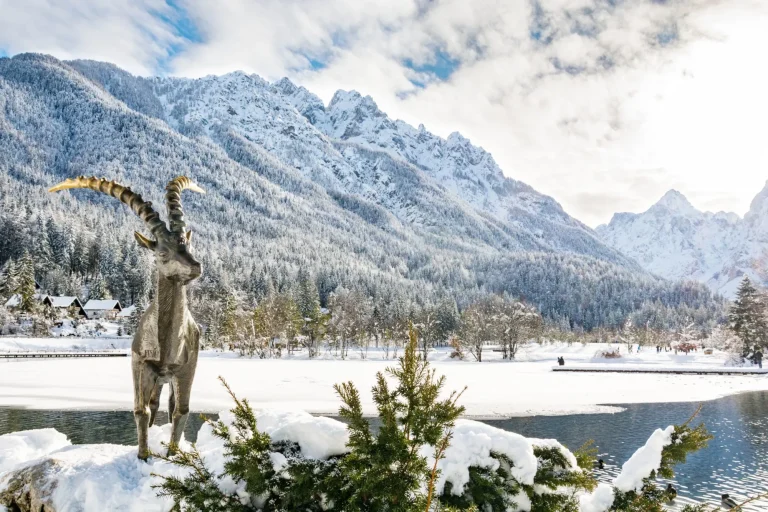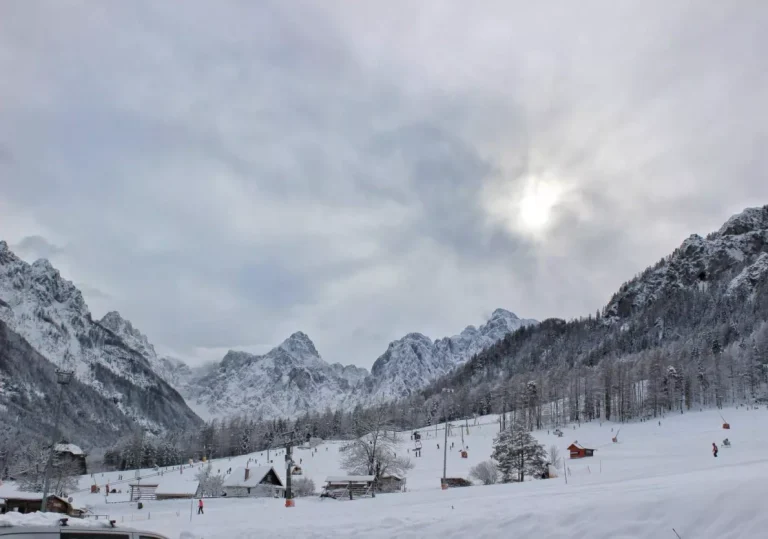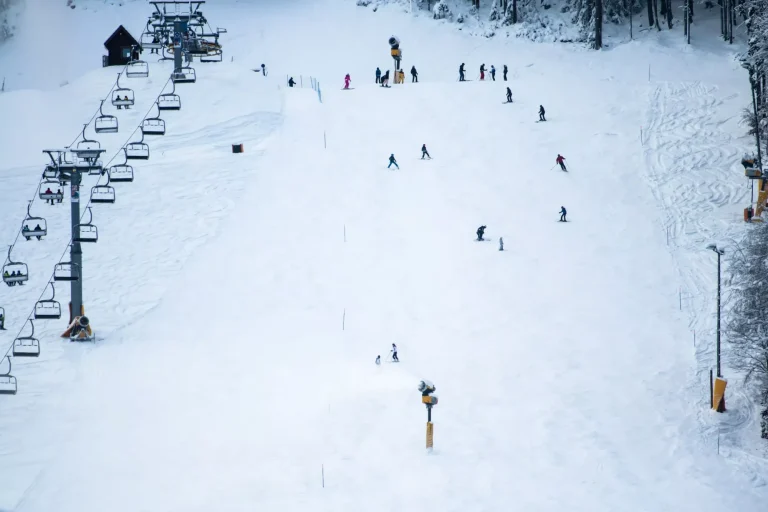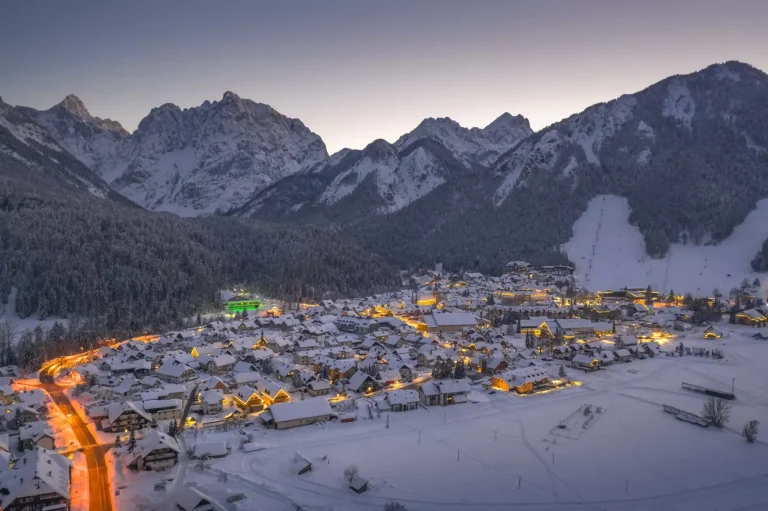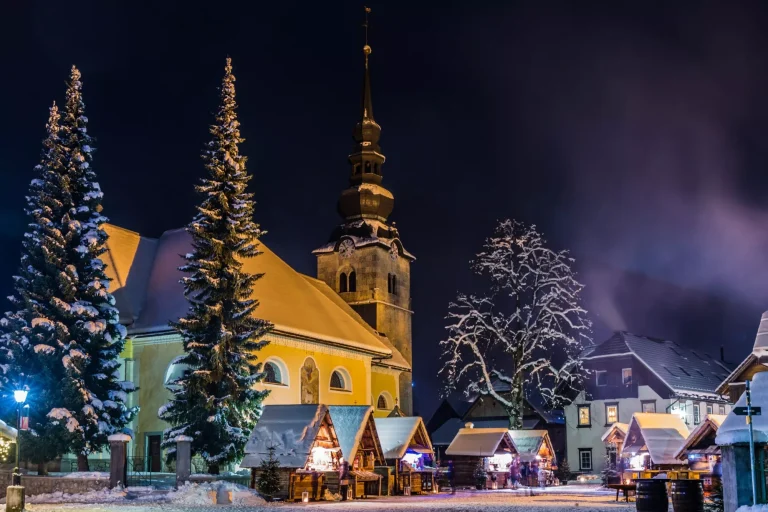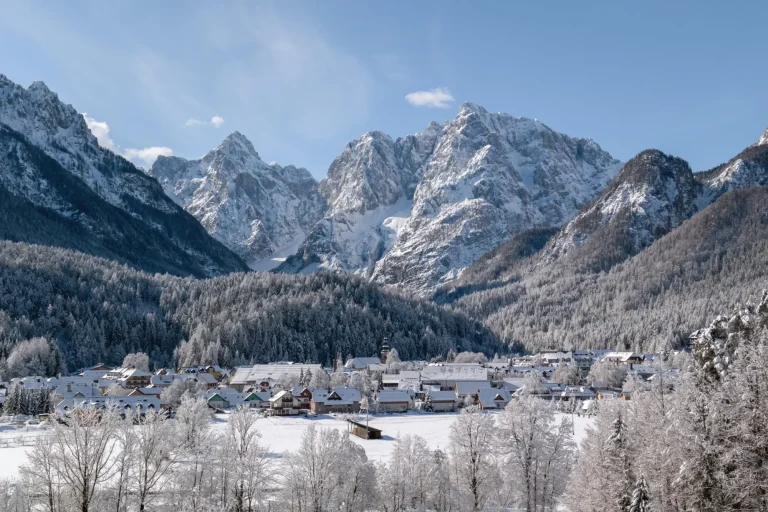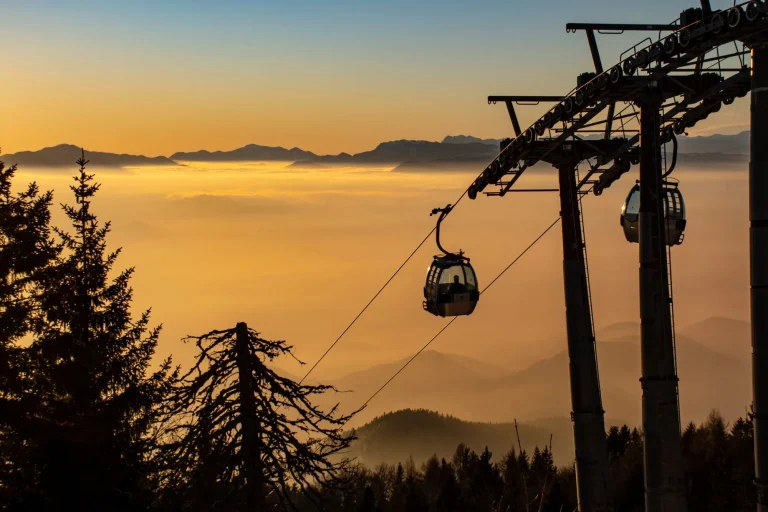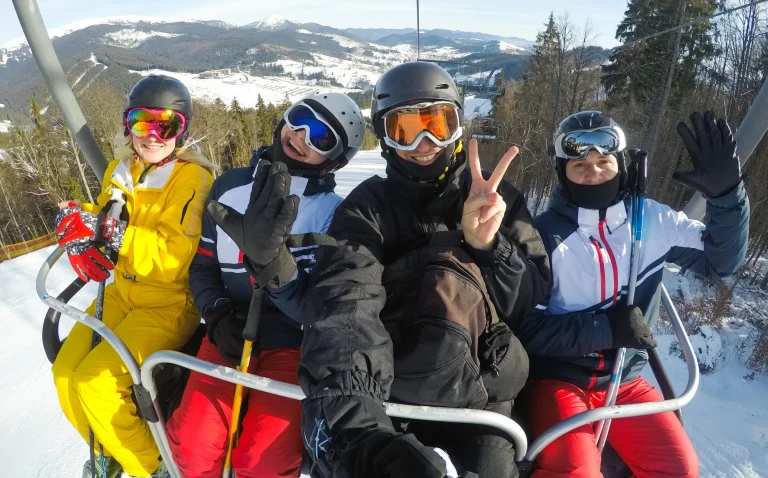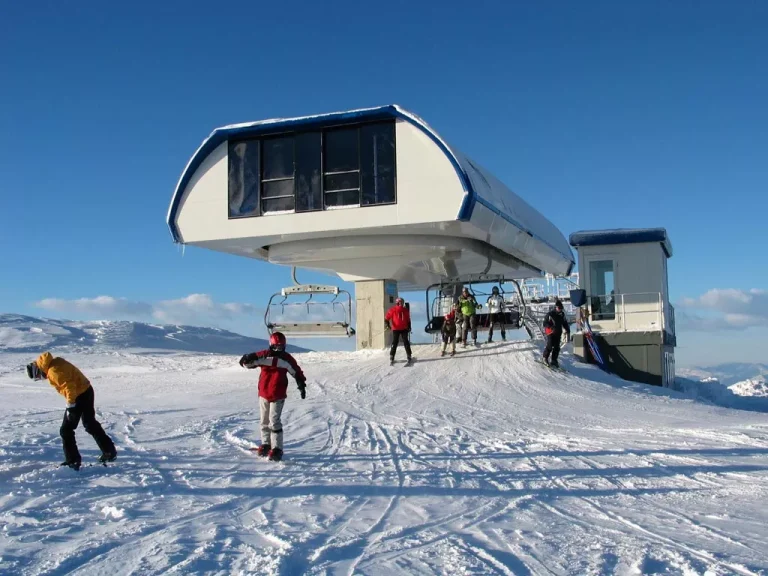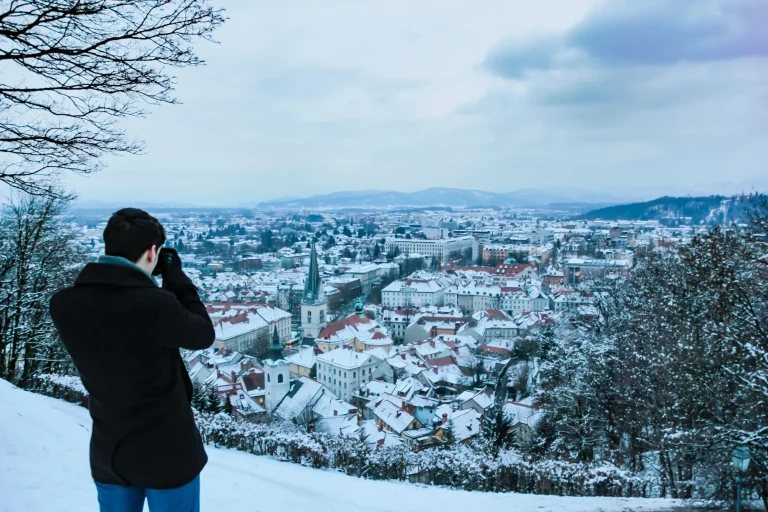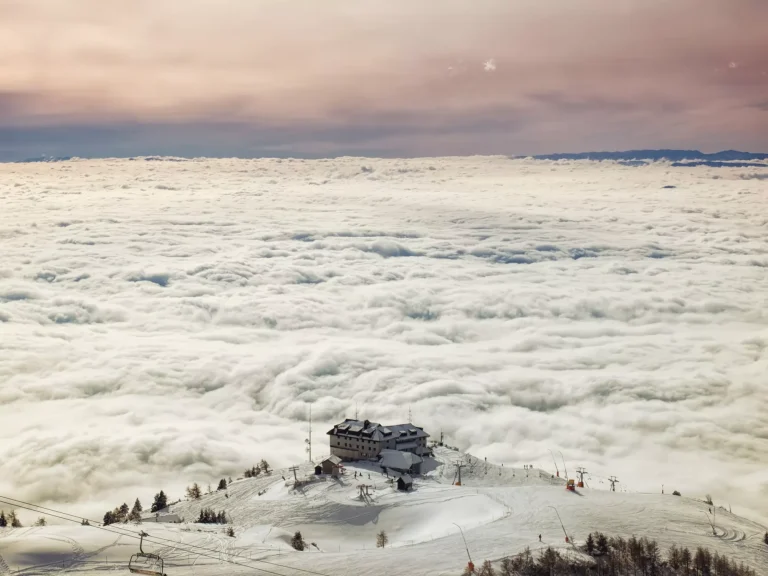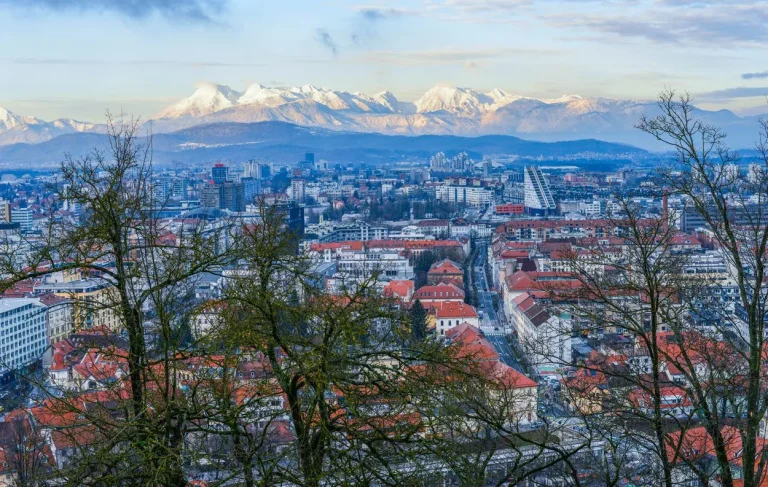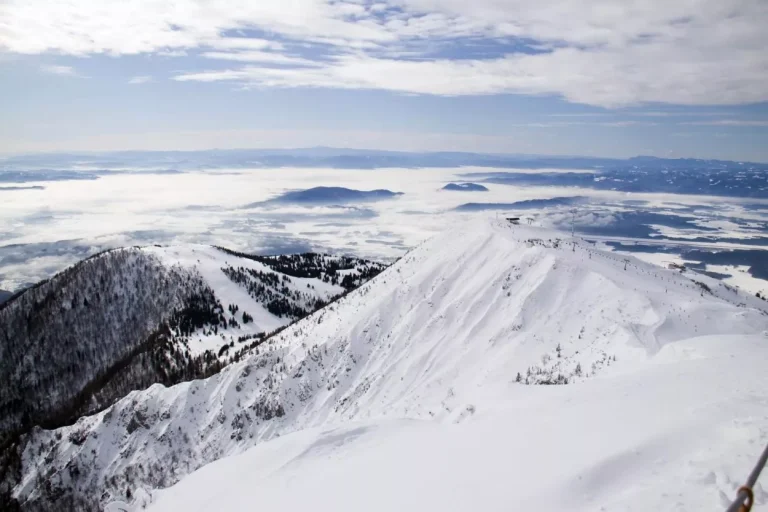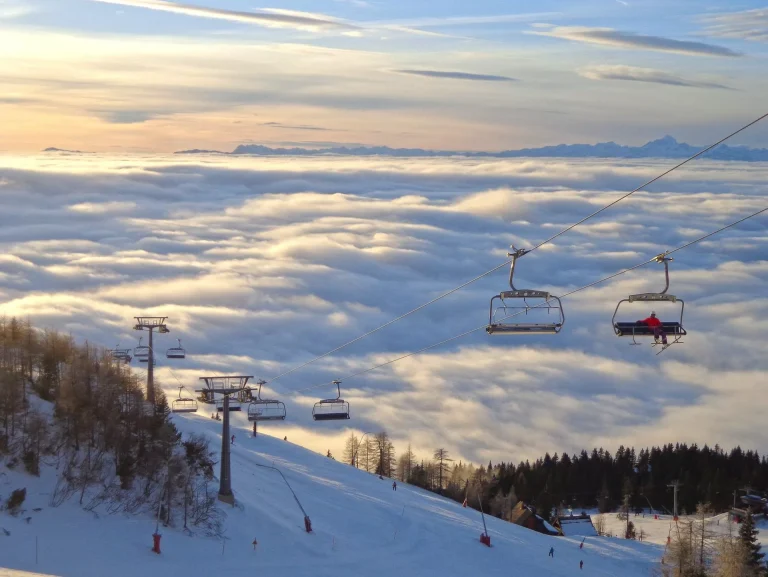Slovenia is a small European country. Its location at the intersection of different geomorphological forms like the Alps, Pannonian Basin, Adriatic Sea, Karst, and Dinarides places it on a diverse piece of land.
Although Slovenia cannot pride itself on encompassing the most substantial share of the Alpine area, Slovenians are inclined to believe it is the most magical. And they are not far from the truth.
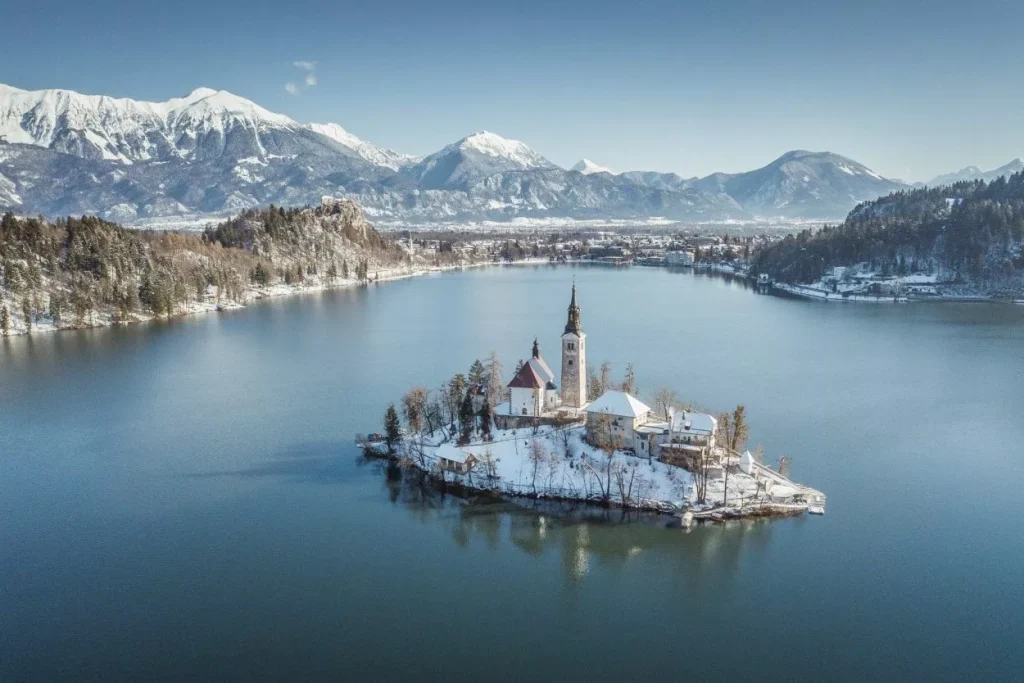
Ski resorts in Slovenia occupy slopes in two of the three mountain ranges in Slovenia, the most famous Julian Alps and the Kamnik-Savinja Alps. In addition, we can also find some of them in the pre-alpine hills.
The highest Alpine peaks in Slovenia do not exceed the mark of 3000 meters of elevation, placing most ski resorts at an altitude between 1000 and 2000 meters. Consequently, the ski season in Slovenia is more dependent on the snow conditions and tends to be shorter. You can read more about it here.
Nonetheless, Slovenia boasts a rich history of skiing, even though its ski resorts do not reach the grandiosity of the ones in Austria, France, Italy, or Switzerland nowadays.
Why Choose Slovenia for Your Next Ski Holiday?
Skiing in Slovenia isn’t your typical Alpine experience – and that’s exactly why it’s so special! If you’re planning a winter getaway, you’re in for something truly unique.
Here are 8 reasons to place Slovenia on your winter bucket list:
1. Small Country, Big Adventures
Slovenia may be a small country, but it’s brimming with winter adventures. Its compact size works in your favor – within just a couple of hours, you can explore completely different terrains and landscapes.
One day you might find yourself carving through fresh powder in the Julian Alps, the next you’re gliding down the slopes in the Kamnik-Savinja Alps or the Pohorje region.
With ski resorts like Vogel, Krvavec, and Rogla all within easy reach, your winter holiday is packed with diversity. And it’s not just about skiing—Slovenia’s rich variety of winter activities means there’s always something new to try each day!
2. Ski Resorts Close to Everything
In Slovenia, accessibility is key—most ski resorts are within an hour’s drive from each other, meaning you can enjoy multiple slopes during your stay without spending long hours on the road. Whether you’re based in a scenic town like Bled or the lively capital of Ljubljana, Slovenia’s top skiing resorts are just a short drive away.
The close proximity of Slovenia’s ski resorts means you can easily experience different slopes throughout your holiday. One day, you could find yourself skiing through the picturesque, tree-lined trails of Vogel, and the next, carving down the open slopes of Krvavec.
And hey, why stop there? Just a short drive away, and you’re carving up the top ski slopes in Italy or Austria, too!
3. Winter Fun for Everyone
Slovenia’s slopes offer something for everyone. Whether you’re a family with young kids, a beginner finding your feet, or an adrenaline-seeking expert, there’s a slope here for you.
Resorts like Rogla and Cerkno are perfect for beginners and families, offering gentle slopes and excellent ski schools. More advanced skiers can challenge themselves on steeper runs at Krvavec or Vogel.
No matter your skill level, Slovenia’s diverse slopes guarantee a fun and fulfilling winter experience.
Have non-skiers in your group? Slovenia has you covered! From snowshoeing to sledding, there’s plenty to keep non-skiers entertained. Read more about these off-the-slopes adventures in the section below.
4. A Ski Escape Without the Crowds
Say goodbye to crowded lifts and busy slopes. In Slovenia, skiing feels more personal and relaxed. Unlike the major ski hubs, Slovenia’s resorts are quieter, allowing you to enjoy the scenery and your time on the slopes without the stress of long lines.
This cozy, intimate atmosphere makes it an ideal choice for those seeking a peaceful winter escape.
Whether you’re hitting the slopes on a weekday when locals are at work or taking advantage of the lower tourist numbers, Slovenia offers a more tranquil ski experience. Here, you can take your time, breathe in the fresh mountain air, and enjoy the snow without the rush.
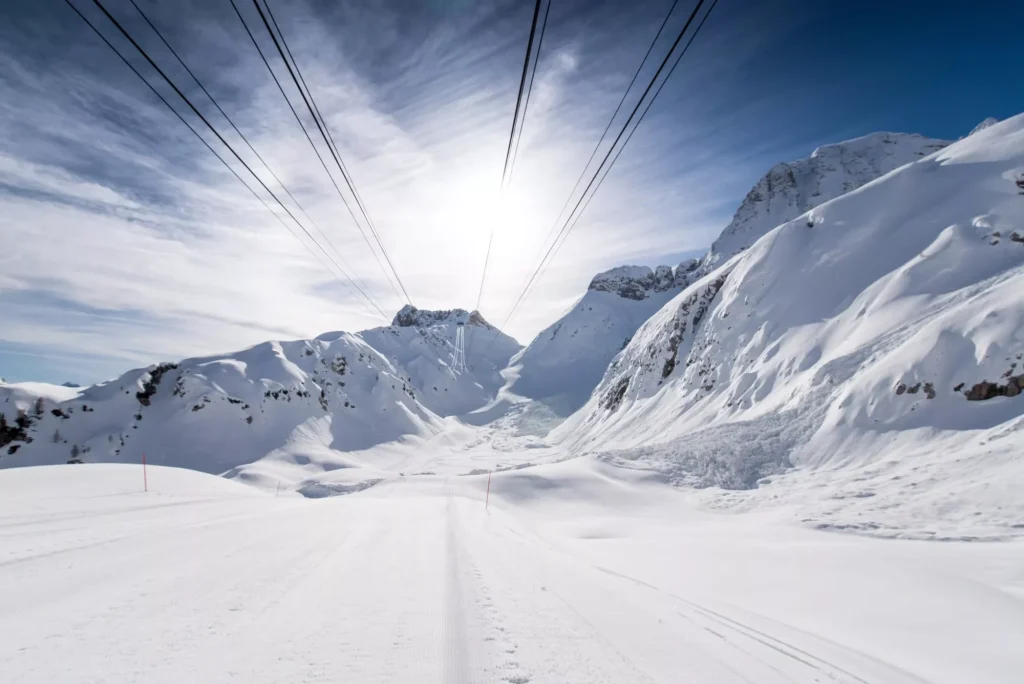
5. Endless Winter Adventures Beyond the Slopes
In Slovenia, skiing is just part of the fun. There’s a whole world of exciting outdoor activities to elevate your winter holiday, whether you’re seeking family-friendly fun or adrenaline-pumping adventures.
Snowshoeing is a perfect way to wander through snow-covered forests of Pokljuka plateau and Tamar valley, while night sledding offers an exciting twist to traditional sledding, giving you the chance to glide down hills under the stars. For something unique, dog sledding lets you race through snowy trails with a team of adorable huskies.
For those looking for more of a challenge, ice climbing on frozen waterfalls and ski touring through Slovenia’s beautiful winter landscapes provide adrenaline-pumping experiences. And for a classic winter activity, ice skating is always available, with the extra thrill that, if temperatures drop low enough, you might be able to skate on the surface of Slovenia’s most iconic landmark – Lake Bled!
These are just a few of the exciting activities you can experience off the slopes, but trust us – there’s no shortage of adventures to make your winter holiday unforgettable!
6. Explore Slovenia’s Top Wonders
When you’re not skiing, Slovenia’s most breathtaking natural spots are just around the corner.
From the famous Lake Bled with its charming island and castle, to the crystal-clear Zelenci Nature Reserve, or the magical icy beauty of Peričnik Waterfall, there’s so much to see. If you’re skiing near Vogel, don’t miss a chance to wander through Triglav National Park, or explore the snow-covered forests of Pokljuka Plateau near Bled and Krvavec.
Can’t decide which to visit? Don’t worry, we’ve got you covered. We’ve prepared some fantastic day trips to ensure you don’t miss a thing, and you can browse them in each ski package.
7. Carve the Slopes of Slovenia’s Skiing Icons
When skiing in Slovenia, you’re not just exploring picturesque slopes—you’re following in the footsteps of Slovenian skiing legends.
This country has a rich alpine skiing tradition, with stars like Tina Maze, a two-time Olympic gold medalist and multiple World Championship winner, training on these very slopes. Her incredible career, with 26 World Cup victories, began right here.
And let’s not forget Ilka Štuhec, a two-time World Champion in downhill skiing. So, while you’re enjoying the slopes, you’re skiing where champions were made!
8. Unbeatable Value for Your Money
Slovenia is the perfect destination for those looking for a high-quality ski holiday that won’t break the bank.
Lift passes, accommodations, and dining are much more affordable here compared to other Alpine destinations, giving you excellent value without sacrificing comfort.
From family-friendly ski passes to delicious, budget-friendly gourmet meals, Slovenia offers an exceptional experience at a fraction of the cost. You can enjoy great skiing, cozy lodgings, and even relaxing wellness treatments—all while staying within your budget.
A Little Glimpse of History
No one can speak of a lack of skiing tradition in Slovenia. The first records of Slovenian skiers date back to 1689 with Bloke skiers. Bloke is a small village in southern Slovenia, and its residents invented wooden skis for their practical use. They allowed them to walk atop the deep snow drifts which covered their vast fields during the winter and made it possible for them to run their everyday errands.
It was the first time in history that skis were used in Central Europe, giving Bloke the flattering title of the cradle of skiing in Central Europe.
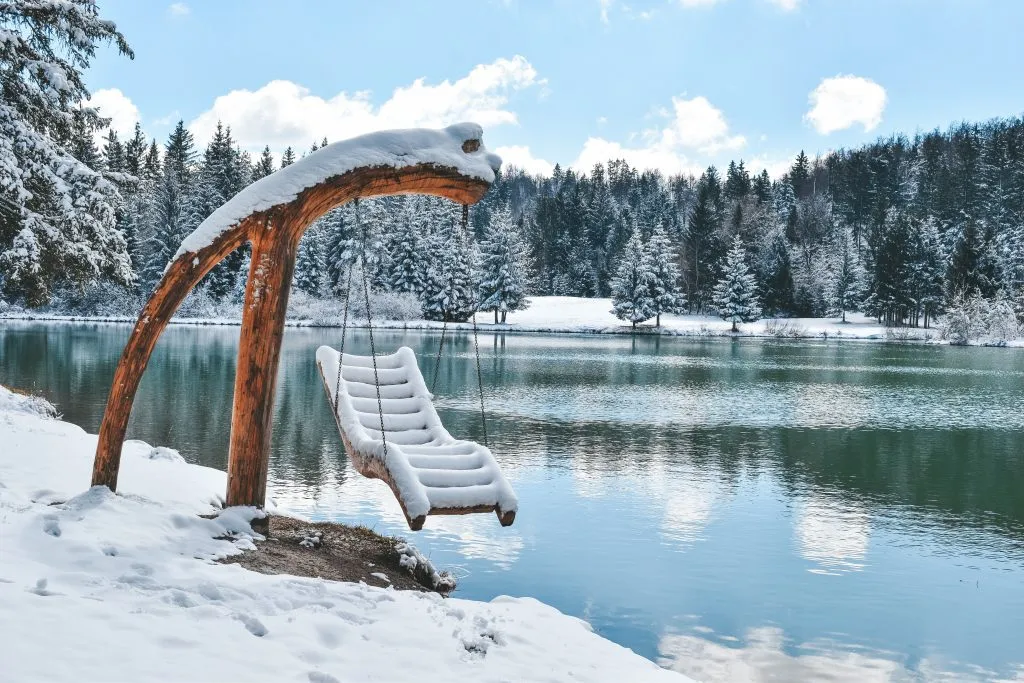
Sports use of skis came to Slovenia with the Scandinavian skis toward the end of the 19th century. After that, the evolution started to grow exponentially, with the first cableway in Slovenia becoming functional around 1950 and the first ski lift following within the next four years.
By 1961 Slovenia got its first official FIS skiing competition, which wrote itself in the history books as the Vitranc Cup, hosted by Kranjska Gora. Ten years later, the famous Planica Nordic Center organized its first World Championship in ski jumping.
Even today, Planica remains the second-largest ski jump in the world and hosts one of the most prestigious matches in the sport of ski jumping annually.
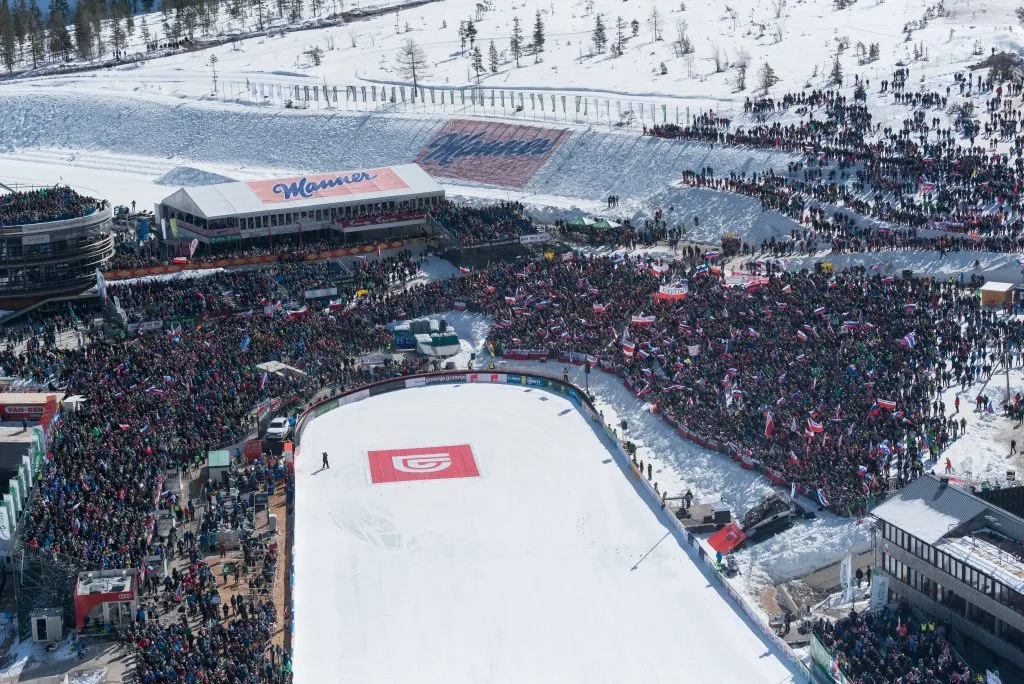
Slovenia has also given birth to many exceptional athletes who left their mark on skiing throughout the sport’s history. Bojan Križaj, Primož Peterka, Jure Košir, and Tina Maze are among the most distinguished.
We must name another Slovenian skiing achievement many forget, although it pushed the limits of what was humanly possible at the time. Davo Karničar was the first man to ski from the top of Mount Everest to the base camp on the Nepalese side of the mountain — on skis of a Slovenian brand no more.
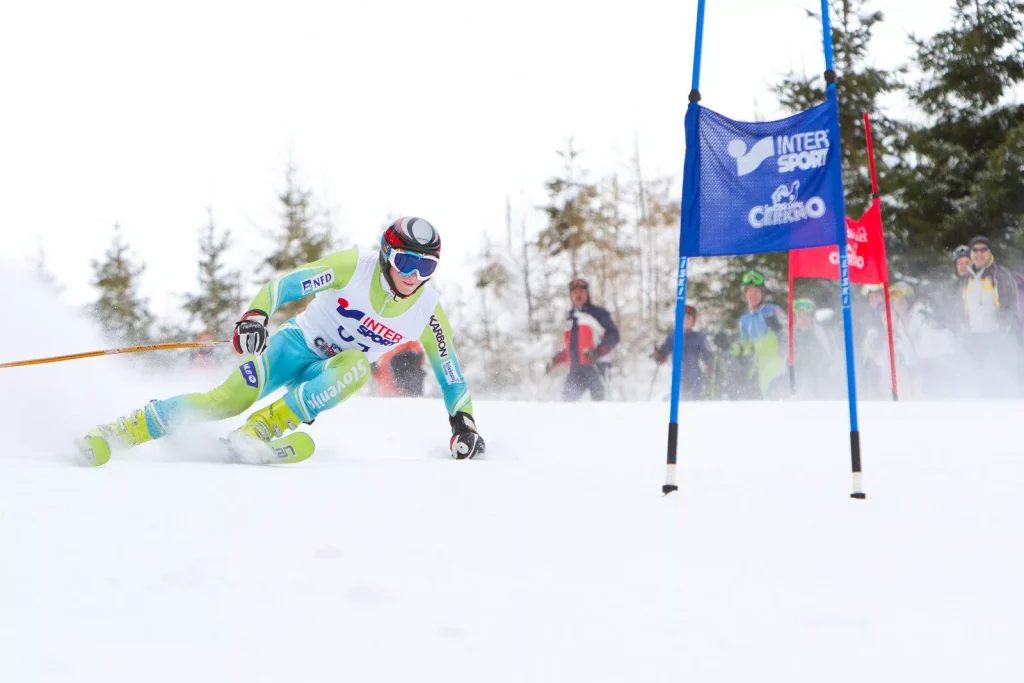
Slovenia has always been a skiing country, and this tradition is still deeply rooted in the nation’s identity.
Slovenian Ski Resorts: Who Are They For?
Slovenia, with its enchanting Alpine vistas and diverse terrains, offers a unique skiing experience that caters to a wide range of skiers. Whether you’re a novice looking to find your skiing feet or an expert seeking challenging slopes, Slovenian ski resorts have something for everyone. Here’s a breakdown of what kind of skiers can best enjoy what Slovenia has to offer.
Beginners and Novices
- Gentle Slopes: Many Slovenian ski resorts feature gentle, wide slopes that are perfect for those just starting out. These beginner-friendly areas allow novices to practice turns and stops without the intimidation of steeper terrains.
- Ski Schools: Almost every major ski resort in Slovenia boasts a ski school with certified instructors offering lessons tailored for beginners. These lessons provide foundational skills and confidence to tackle more challenging slopes in the future.
- Family-Friendly Facilities: For families with young children or first-time skiers, Slovenian resorts often have amenities like kiddie parks and easy-to-use lifts.
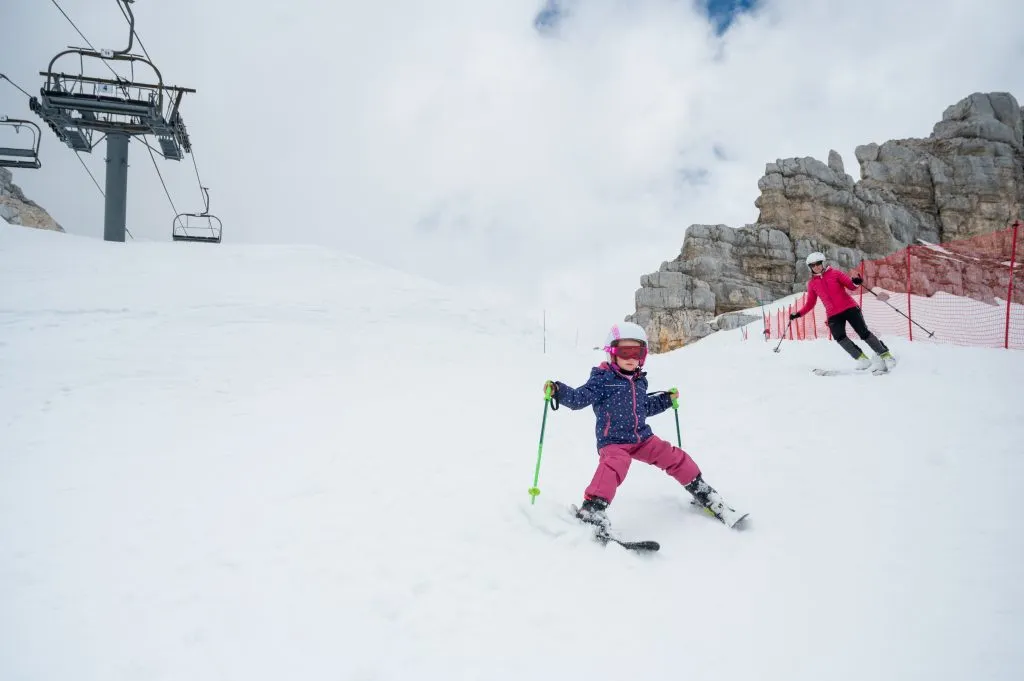
Intermediate Skiers
- Varied Terrains: Intermediate skiers will find a plethora of slopes that offer a mix of challenges, from long cruising runs to more technical sections that help refine skiing techniques.
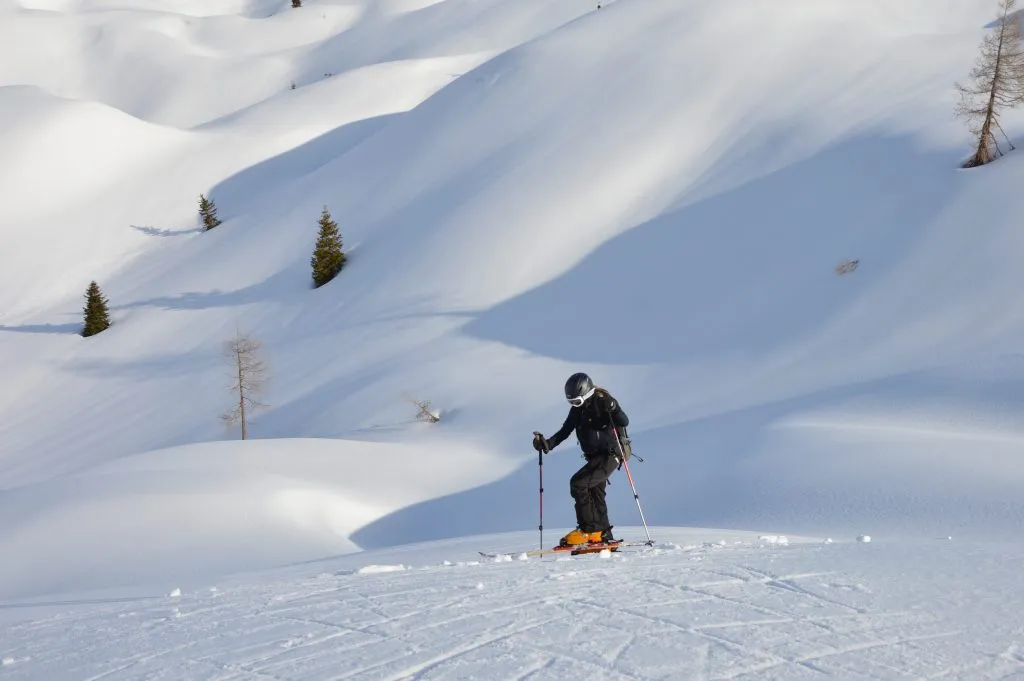
Advanced and Expert Skiers
- Challenging Slopes: While Slovenia might not have the vast vertical drops of some larger Alpine resorts, it does offer steep, challenging runs that can test even seasoned skiers.
- Off-Piste Opportunities: For those seeking powder and untouched terrains, certain Slovenian resorts offer off-piste skiing opportunities. However, it’s essential to be aware of avalanche risks and always venture out with proper equipment and, ideally, a local guide.
- Race Tracks: Some resorts have FIS-approved race tracks, allowing advanced skiers to experience the thrill of racing down professional-standard slopes.
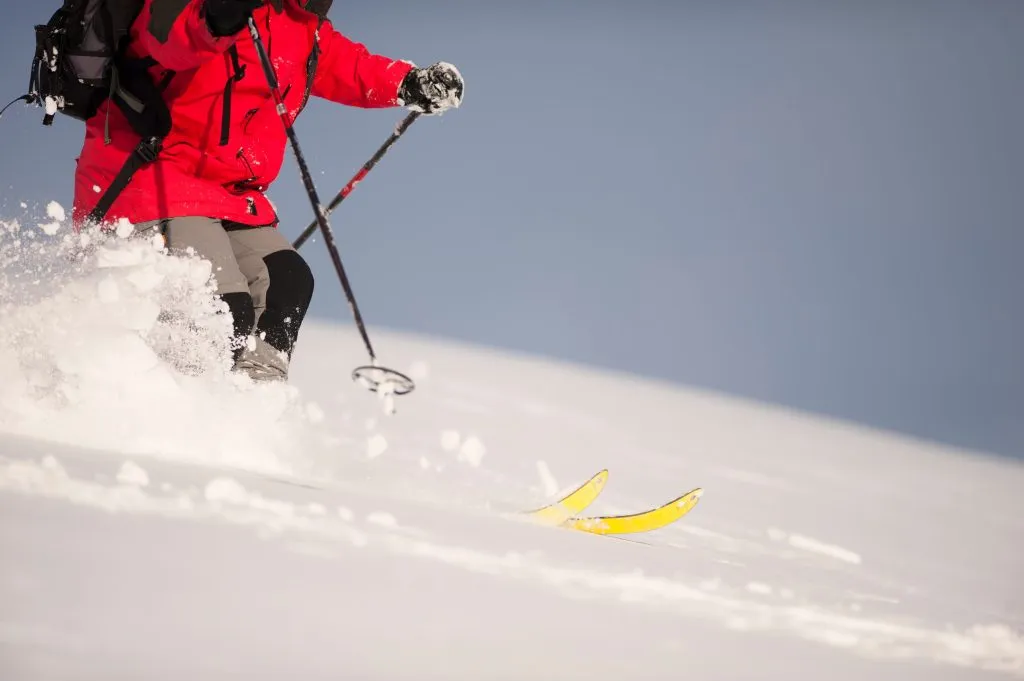
Slovenian ski resorts, with their diverse offerings and inclusive approach, ensure that skiers of all skill levels and preferences can find their perfect snowy paradise. Whether you’re seeking serene slopes, challenging terrains, or picturesque cross-country trails, Slovenia welcomes you with open arms and pristine snow. For a deeper dive into our ski resorts, explore our comprehensive guide.
Safety and Skiing Guidelines in Slovenia
Skiing in the picturesque landscapes of Slovenia is an exhilarating experience, but safety should always be a top priority. Whether you’re a seasoned skier or setting foot on the slopes for the first time, adhering to safety guidelines ensures a memorable and accident-free skiing adventure. Here are some essential safety tips and guidelines to keep in mind while skiing in Slovenia.
Avalanche Awareness
- While Slovenian ski resorts take significant measures to prevent avalanches, it’s crucial for skiers to be aware of the risks, especially if venturing off-piste.
- Always check the local avalanche forecast before heading out and be cautious of recent snowfalls, which can increase avalanche risks.
- If you plan to ski in backcountry areas, consider taking an avalanche safety course and always carry essential equipment like a beacon, shovel, and probe.
Helmet Usage
- Wearing a helmet is non-negotiable. It significantly reduces the risk of head injuries in case of falls or collisions.
- Ensure your helmet meets international safety standards and fits snugly without being too tight.
- Remember, a helmet isn’t just for beginners; even experienced skiers can encounter unexpected situations.
Guidelines for Beginners
- If you’re new to skiing, consider taking lessons from certified instructors available at most Slovenian ski resorts. They’ll teach you the basics and essential techniques to navigate the slopes safely.
- Start with beginner slopes, often marked in green, before progressing to more challenging terrains.
- Learn the skiing code of conduct, which includes rules like giving way to skiers in front and checking uphill before merging onto a trail.
Ski Equipment Check
- Ensure your skiing equipment, especially bindings, is in good condition and appropriately adjusted for your weight and skill level.
- Regularly check and maintain your equipment. Sharp ski edges, a well-maintained base, and properly adjusted bindings can make a significant difference in ski performance and safety.
Respect Ski Signs and Markings
- Ski resorts in Slovenia have clear signs indicating the difficulty level of slopes, directions, and other essential information. Always adhere to these signs and avoid venturing into closed areas.
- Be especially cautious around areas marked with warnings or hazard signs.
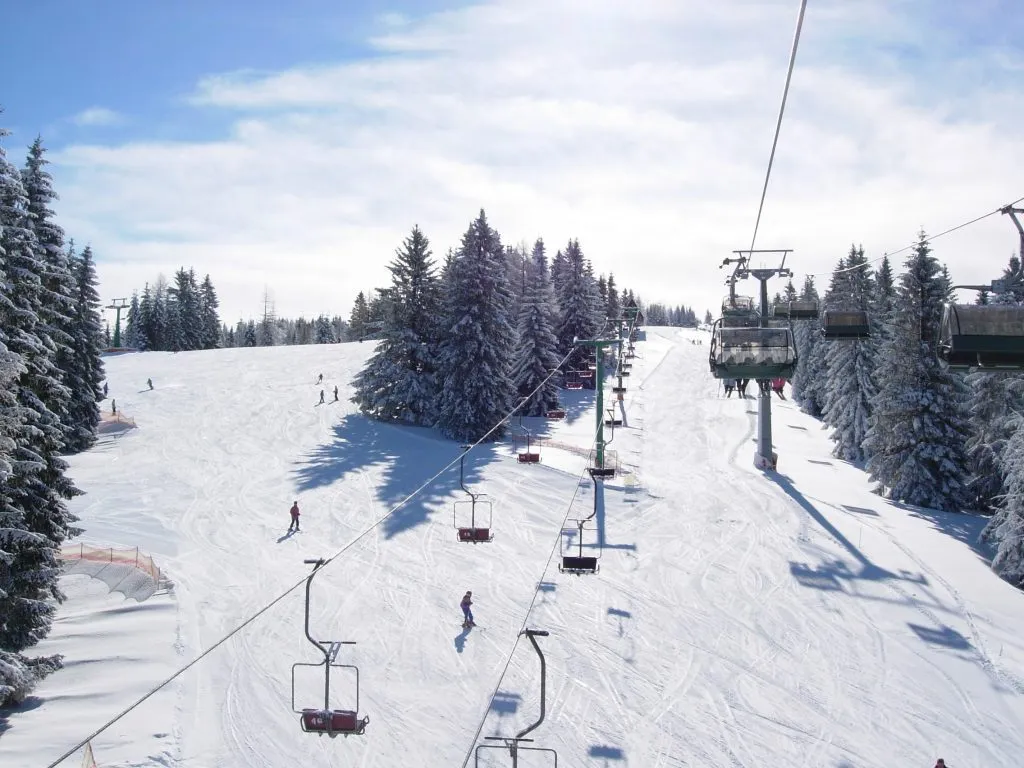
Stay Within Your Limits
- It’s essential to recognize your skill level and not push yourself too hard, or too fast. Fatigue can lead to accidents, so take regular breaks and stay hydrated.
- If you feel out of your depth on a particular slope, there’s no shame in retreating and trying again another time.
Be Aware of Changing Weather Conditions
- Mountain weather can be unpredictable. Sudden snowstorms, reduced visibility, or dropping temperatures can make skiing dangerous. Always check the weather forecast before heading out and be prepared to adjust your plans if necessary.
By adhering to these safety guidelines and being aware of your surroundings, you can ensure that your skiing experience in Slovenia is not only thrilling but also safe. Remember, the mountains will always be there, so prioritize safety above all else.
Unforgettable Ski Holidays in Slovenia
Slovenia is a jewel waiting to be explored by many still. Most people like to visit the country during summer to discover its hidden corners, hike the stunning Alps, or swim in its emerald rivers and lakes. But winter brings out a different kind of magic in its landscape.
And the majority of Slovenians can barely wait for the snow to cover the Alps, which kicks off the ski season. We thoroughly adore seeing our slopes dressed in white.
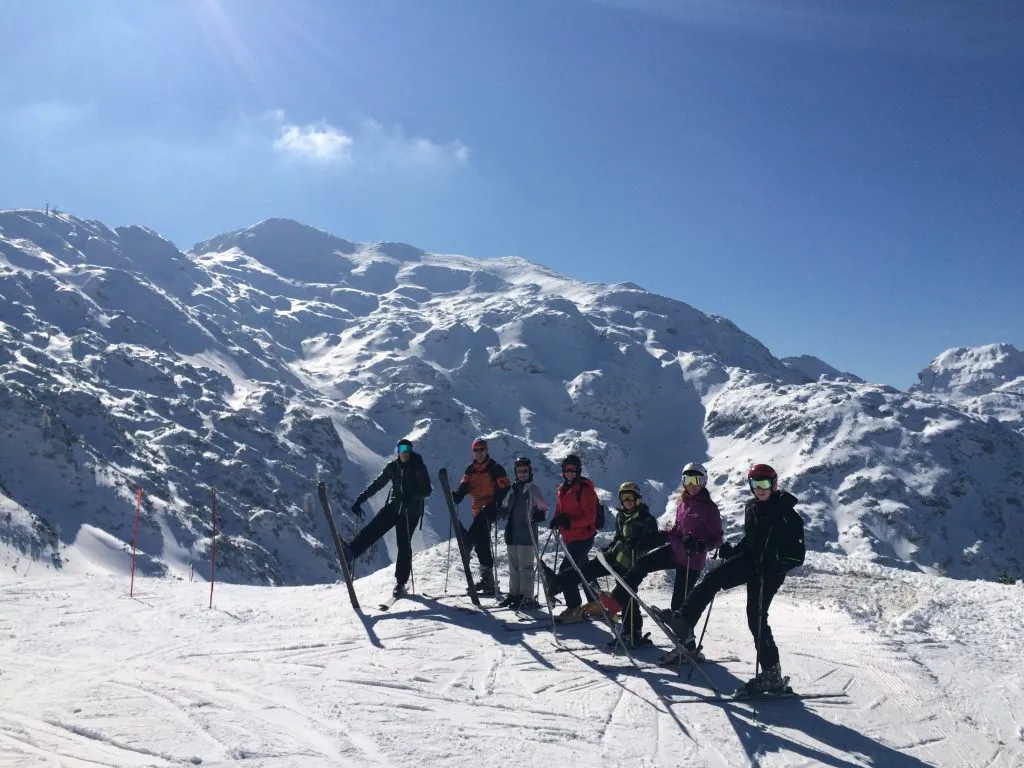
There is nothing else to add apart from our assurance that Slovenia is an excellent destination for ski holidays that never leaves anybody disappointed. Quite the opposite.
We would be delighted to welcome skiers to our small country on the sunny side of the Alps.
Check out our expertly crafted Slovenia Ski Packages and book your unforgettable ski holidays in Slovenia.



